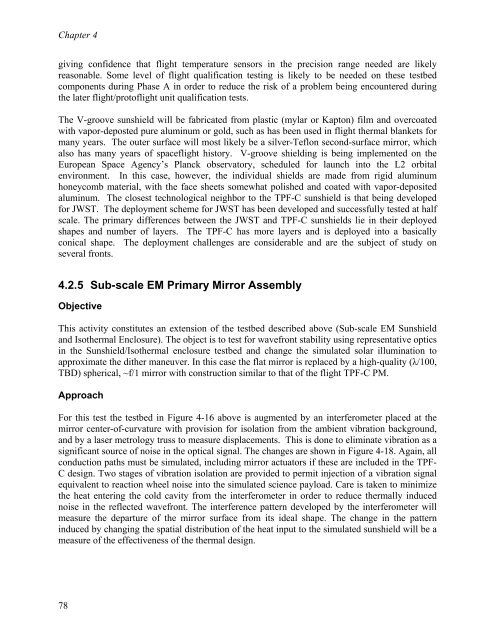TPF-C Technology Plan - Exoplanet Exploration Program - NASA
TPF-C Technology Plan - Exoplanet Exploration Program - NASA
TPF-C Technology Plan - Exoplanet Exploration Program - NASA
Create successful ePaper yourself
Turn your PDF publications into a flip-book with our unique Google optimized e-Paper software.
Chapter 4<br />
giving confidence that flight temperature sensors in the precision range needed are likely<br />
reasonable. Some level of flight qualification testing is likely to be needed on these testbed<br />
components during Phase A in order to reduce the risk of a problem being encountered during<br />
the later flight/protoflight unit qualification tests.<br />
The V-groove sunshield will be fabricated from plastic (mylar or Kapton) film and overcoated<br />
with vapor-deposted pure aluminum or gold, such as has been used in flight thermal blankets for<br />
many years. The outer surface will most likely be a silver-Teflon second-surface mirror, which<br />
also has many years of spaceflight history. V-groove shielding is being implemented on the<br />
European Space Agency’s <strong>Plan</strong>ck observatory, scheduled for launch into the L2 orbital<br />
environment. In this case, however, the individual shields are made from rigid aluminum<br />
honeycomb material, with the face sheets somewhat polished and coated with vapor-deposited<br />
aluminum. The closest technological neighbor to the <strong>TPF</strong>-C sunshield is that being developed<br />
for JWST. The deployment scheme for JWST has been developed and successfully tested at half<br />
scale. The primary differences between the JWST and <strong>TPF</strong>-C sunshields lie in their deployed<br />
shapes and number of layers. The <strong>TPF</strong>-C has more layers and is deployed into a basically<br />
conical shape. The deployment challenges are considerable and are the subject of study on<br />
several fronts.<br />
4.2.5 Sub-scale EM Primary Mirror Assembly<br />
Objective<br />
This activity constitutes an extension of the testbed described above (Sub-scale EM Sunshield<br />
and Isothermal Enclosure). The object is to test for wavefront stability using representative optics<br />
in the Sunshield/Isothermal enclosure testbed and change the simulated solar illumination to<br />
approximate the dither maneuver. In this case the flat mirror is replaced by a high-quality (λ/100,<br />
TBD) spherical, ~f/1 mirror with construction similar to that of the flight <strong>TPF</strong>-C PM.<br />
Approach<br />
For this test the testbed in Figure 4-16 above is augmented by an interferometer placed at the<br />
mirror center-of-curvature with provision for isolation from the ambient vibration background,<br />
and by a laser metrology truss to measure displacements. This is done to eliminate vibration as a<br />
significant source of noise in the optical signal. The changes are shown in Figure 4-18. Again, all<br />
conduction paths must be simulated, including mirror actuators if these are included in the <strong>TPF</strong>-<br />
C design. Two stages of vibration isolation are provided to permit injection of a vibration signal<br />
equivalent to reaction wheel noise into the simulated science payload. Care is taken to minimize<br />
the heat entering the cold cavity from the interferometer in order to reduce thermally induced<br />
noise in the reflected wavefront. The interference pattern developed by the interferometer will<br />
measure the departure of the mirror surface from its ideal shape. The change in the pattern<br />
induced by changing the spatial distribution of the heat input to the simulated sunshield will be a<br />
measure of the effectiveness of the thermal design.<br />
78
















